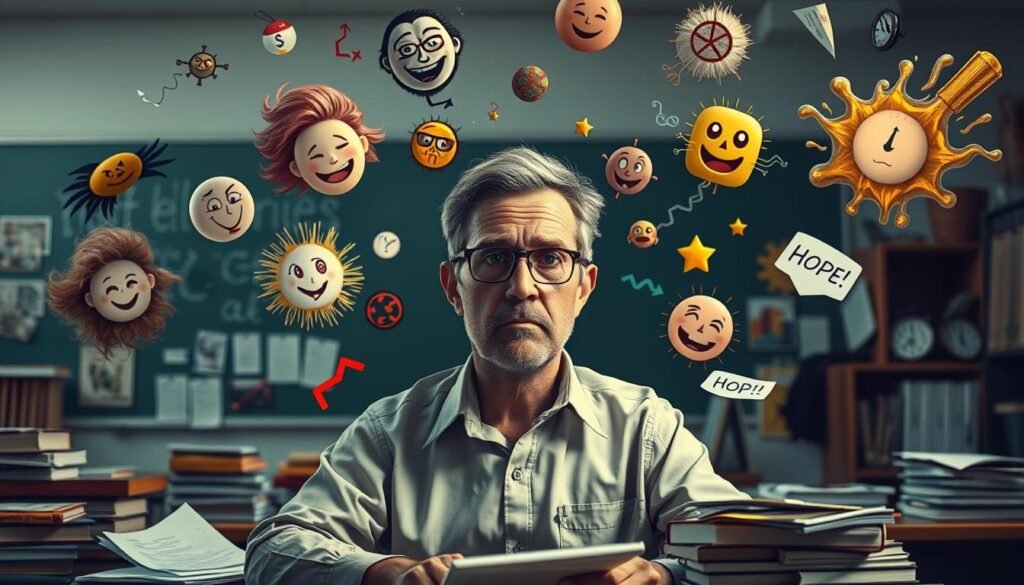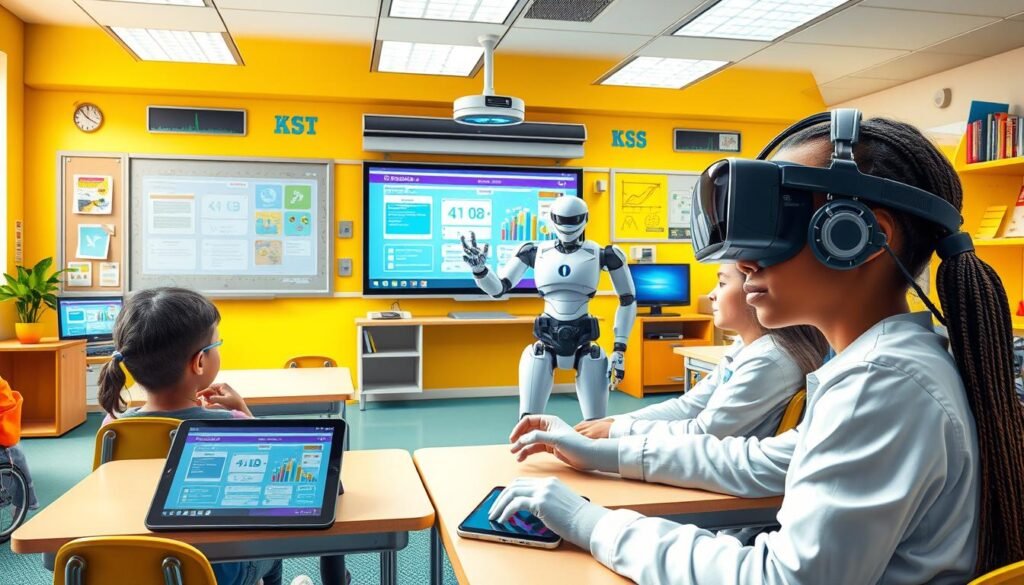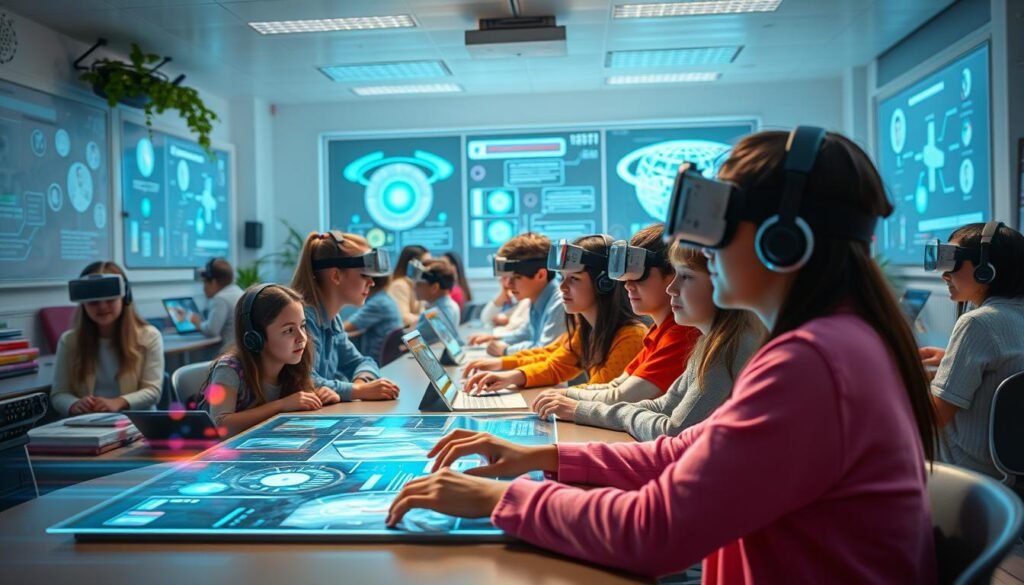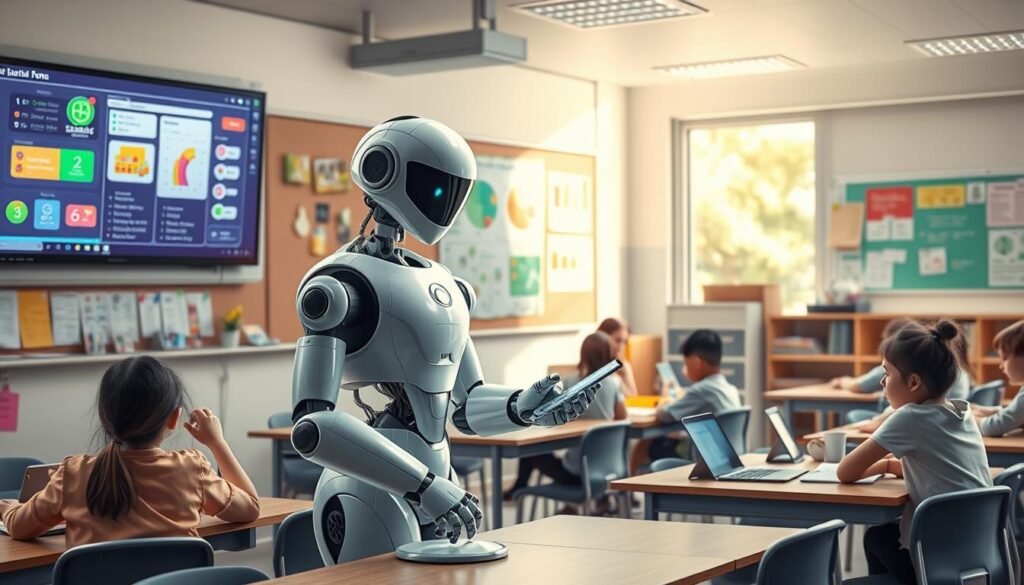“In the midst of chaos, there is also opportunity.” These words by Sun Tzu are very relevant today. Teacher burnout and attrition are at high levels. Artificial intelligence in education technology offers hope. It can automate tasks and lessen the workload, making teaching better and helping keep teachers.
This article will look at how AI and teacher burnout are connected. AI can help with lesson planning and grading, easing teachers’ heavy loads. Using technology wisely is key to improving education’s future. For more on how AI can change teaching, check out this insightful resource.
Key Takeaways
- AI tools can alleviate teacher workload and improve job satisfaction.
- Strategic implementation of AI may lead to better teacher retention rates.
- Addressing ethical and privacy concerns around AI in education is essential.
- AI has the potential to enhance the teaching experience through automation.
- Balancing technology use with personal interactions is key to effective teaching.
Understanding Teacher Burnout and Attrition
Teacher burnout is a big issue in education. It’s marked by feeling drained, feeling like you’re just going through the motions, and feeling like you’re not achieving anything. Teachers deal with a lot of pressure from all sides. This leads to a drop in their well-being and how well they can do their jobs.
Too much work and emotional stress are big parts of burnout. Many teachers end up thinking about leaving their jobs because of it. This makes teacher attrition go up.
What is Teacher Burnout?
Teacher burnout is all about feeling constantly stressed, tired, and disconnected. It comes from having too much work and dealing with a lot of emotional demands. As stress builds up, teachers find it hard to feel good about what they do.
This not only hurts the teacher but also the whole school. The effects on teacher well-being can make students less engaged and less happy.
The Impact of Teacher Attrition on Education
When a lot of teachers leave, it’s bad news for schools, especially in poor areas. It makes learning unstable, slows down student progress, and breaks up the flow of learning. When experienced teachers go, schools often get new teachers who don’t have as much experience.
This can make things worse for students. Finding out why teachers burn out and how to keep good teachers can help make schools better for students.
Factors Contributing to Teacher Burnout
Many things make teaching hard and lead to burnout. It’s important to know these factors to help teachers feel better.
Workload and Administrative Burdens
Teachers often have too much to do, not just teaching. They work about 50 hours a week on tasks like planning lessons, grading, and going to meetings. This heavy workload and extra duties cause a lot of stress.
With more emails and paperwork, burnout is a big worry.
Lack of Support and Resources
Teachers often don’t get the support they need. They don’t have enough materials or help, which makes their job harder. Many feel alone, dealing with tough students without help from others, which makes stress worse.
Emotional Demands of Teaching
Teaching is emotionally tough. Teachers must be very patient and strong to handle different students. It’s hard for them to keep their own mental health while helping students. This emotional strain can hurt teachers and the classroom environment.

We need to tackle these big problems to make schools better for teachers. Knowing how workload, support, and emotional demands connect can help us find solutions.
| Factor | Description | Impact on Teacher Well-Being |
|---|---|---|
| Workload | Excessive hours spent on non-teaching tasks | Increases stress and reduces job satisfaction |
| Administrative Burdens | Time-consuming paperwork and requirements | Leads to frustration and burnout |
| Lack of Support | Insufficient resources and help | Creates feelings of isolation |
| Emotional Demands | Handling diverse student needs and behaviors | Challenges mental health and resilience |
For more on how tech can help ease these issues, check out the latest in AI and education.
The Role of AI in Education
Artificial intelligence in education marks a big change in how we learn. It uses human-like intelligence to make learning more personal and efficient. AI tools help solve big problems faced by teachers and make learning easier.
What is Artificial Intelligence in the Classroom?
In the classroom, AI is a game-changer. It lets teachers use data to make their teaching better. AI helps track how students are doing and spot areas they need help in. This tech makes learning more fun and flexible for everyone.
Applications of AI Tools in Education
AI tools have many uses that help both students and teachers. Some key examples are:
- Intelligent Tutoring Systems: These systems give one-on-one lessons that match what each student needs, making learning more engaging.
- Automated Grading: AI can quickly and fairly grade work, freeing up teachers to focus on teaching.
- Adaptive Learning Platforms: These platforms change what they teach based on how well students are doing, helping everyone learn at their own pace.
Using AI can cut down on busy work for teachers. This gives them more time to build relationships and help students learn. It’s important for teachers to know about data privacy and how to control it. This helps them make smart choices about using educational tools. For more info on data practices, check out this resource.
| AI Application | Benefits |
|---|---|
| Intelligent Tutoring Systems | Personalized instruction for improved learning outcomes |
| Automated Grading | Efficient grading processes and more time for teaching |
| Adaptive Learning Platforms | Customized learning experiences that adapt to student needs |
AI AND Teacher Burnout and Attrition
Using AI to help teachers can make schools better places to work. AI can take over tasks like grading and planning lessons. This lets teachers focus more on helping students and making lessons better. It can make teachers feel less stressed and might help them stay in their jobs longer.
How AI can Alleviate Teacher Stress
AI is changing how we teach. By using AI tools, teachers can:
- Have less work with automated tasks
- Give students more personal support, making teachers happier
- Have more time and resources for making lessons creative
These changes are big steps towards making teaching easier with AI. They help create a better work environment for teachers.
Case Studies Showcasing AI Usage
Many studies show how AI helps teachers. In California, schools used adaptive learning tools. This made students more engaged and teachers happier. Teachers felt less stressed because the tools adjusted learning to fit each student’s needs.
| Case Study | Implementation Area | Outcome |
|---|---|---|
| Adaptive Learning Platforms | California Schools | Enhanced job satisfaction and reduced stress levels for teachers |
| AI Grading Tools | New York Districts | Improved efficiency in grading processes, allowing more time for student interaction |
These studies show how AI can help with teacher burnout. The good results from these technologies suggest AI can help keep more teachers in the profession. For more info, check out this resource.

Automating Administrative Tasks with AI
AI brings big benefits to schools by helping teachers manage their work better. It automates routine tasks, letting teachers focus more on teaching. This makes learning better for students.
Reducing Lesson Preparation Time
AI helps teachers save time on lesson planning. Tools like Fetchy make it easy to create lesson plans. They give teachers quick access to resources they need.
This automation cuts down on the boring parts of planning lessons. Teachers can then spend more time making lessons fun and engaging for students.
Streamlining Grading Processes
Grading work gets easier with AI. Tools like Enlighten AI quickly check student work. They can analyze answers, making grading faster and more accurate.
This makes grading less time-consuming. Teachers can give feedback faster, making classes more lively.
Enhanced Work-Life Balance through AI
Technology is key to helping teachers overcome their challenges. AI tools help teachers save time by automating tasks like grading and planning. This lets them focus more on their personal lives, improving their well-being.
Reclaiming Time for Personal Life
Teachers can now spend less time on tasks like grading and planning thanks to AI. This means they have more time for hobbies and family. Tools like the one Sam Anderson-Moxley created show how AI can make daily tasks easier.
These tools help teachers work more efficiently. They can now relax and take care of themselves with the extra time.
Improving Emotional Well-Being
Teachers with less time on mundane tasks can focus on self-care. This leads to a more rewarding teaching experience and less burnout. They can enjoy hobbies, connect with colleagues, and relax more easily.
This leads to better emotional health for teachers and a positive school environment. It helps everyone involved feel better.

Using AI in education makes teachers’ lives better in many ways. It makes them more efficient and creates a supportive work environment. This leads to growth and happiness in their careers.
The Benefits of Personalized Learning with AI
Personalized learning is key in today’s education, thanks to AI. It uses adaptive learning tech to make lessons fit each student’s needs. This way, students learn better and teachers get less stressed.
Adaptive Learning Platforms
Adaptive learning platforms use algorithms to check how students are doing. They change the lesson content based on how well students are doing. This means students get lessons that are just right for them. The main features of these platforms are:
- Real-time feedback that helps students on their learning path.
- Course customization for changing the difficulty and speed of lessons.
- Data analytics to help teachers see how students are doing and what they need help with.
AI-Powered Tutoring Systems
AI tutoring systems give extra help outside the classroom. They make learning even more personal by offering one-on-one help that fits the student’s way of learning. The benefits are:
- Access to on-demand assistance for tough topics.
- The chance to learn at their own speed, gaining confidence and skill without stress.
- More fun learning with interactive tools and games.
With AI and adaptive tech, schools can meet the needs of all students better. This method helps students learn more effectively and helps teachers too. It makes teaching more sustainable for everyone.
AI Tools for Mental Health Support in Education
In today’s fast-paced education world, mental health support is key. AI tools help teachers deal with stress, making the classroom a better place. These tools can spot when teachers are feeling stressed, helping to improve well-being.
Identifying Teacher Stress Levels
AI looks at different data to find when teachers are stressed. It checks workload, emotional health, and feedback online. This helps schools tackle stress early and offer help when needed.
Providing Coping Strategies
After spotting stress, AI gives teachers personal ways to feel better. This might include mindfulness, better time management, and links to mental health help. This approach helps teachers handle stress well, making work more enjoyable and effective.

Challenges and Concerns About AI in Education
AI in schools has many benefits, but it also brings challenges. Privacy and ethical issues are big concerns. Schools collect a lot of student data, making people worry about how it’s used and kept safe.
Privacy Issues and Ethical Considerations
There’s a big worry about misuse of student data. AI looks at how students do and behave, making privacy hard to keep. Schools must think about the algorithms used in AI to avoid biases that could affect students.
Legal rules are needed to protect student data and support new teaching methods. This ensures students’ information stays safe while helping education improve.
The Risk of Dehumanizing Education
Using too much AI could make learning less personal. It might reduce the important bond between teachers and students. AI can make things more efficient, but it shouldn’t replace human touch in teaching.
It’s important to find a good balance. This way, we keep the personal touch in learning while using AI to help.
| Concern | Impact | Strategies for Mitigation |
|---|---|---|
| Privacy Concerns | Potential data breaches and misuse of personal information | Implement robust data protection policies |
| Ethical Considerations | Bias in AI decision-making affecting student evaluations | Regular audits of AI algorithms for fairness |
| Dehumanization | Reduction in personal connections between students and educators | Encourage AI use as a supplementary tool, not a replacement |
As AI gets better, we need to keep working on these issues. We want a responsible use of technology in schools. Research, like the McKinsey report, shows us how to do this right. It helps make learning better for everyone.
Educational Innovation: Examples of AI in Use
AI is changing education by making things easier and helping teachers more. Tools like Fetchy and Enlighten AI show how AI can make learning better and help teachers. They are great examples of how AI can improve education and support teachers.
Fetchy: A Personal Assistant for Teachers
Fetchy is a personal assistant for teachers. It helps them with daily tasks. With AI, teachers can focus more on teaching and less on paperwork. Fetchy makes lesson planning and scheduling easy, making teaching better and more productive.
Enlighten AI: Grading Assistance for Educators
Enlighten AI helps teachers grade papers faster. It uses smart algorithms to check student work quickly. This means teachers can give feedback right away and spend more time with students. It helps teachers work less and engage more with their students.

Using innovative AI applications in teaching is a big step towards helping teachers and improving education. As AI gets better, it will play a key role in the future of learning. For more information, check out the U.S. Department of Education’s report on AI in education here.
The Future of AI in Education
The future of AI in education is set to change a lot. New AI tools will make learning more efficient and effective. They will help teachers and students in big ways.
Potential Developments in AI Technology
AI is getting better and will play a bigger role in schools. It will create learning experiences that fit what each student needs. Teachers will use AI to help with simple tasks, so they can focus more on helping students.
This change will make teaching more about guiding and less about just sharing information. Studies show AI can also make teachers happier at work.
Predictions for Teacher Roles
Teachers and AI will work together more closely in the future. AI won’t replace teachers but will help them with paperwork and give students more personal attention. This means teachers will need to be good at understanding people and emotions.
This approach shows that AI and humans work well together in education. It highlights the importance of human touch in teaching. For more on how AI helps teachers, check out the impact of AI on teacher well-being.

The Importance of Teacher Retention
Keeping a steady teaching staff is key for schools to do well. When teachers leave often, it creates big problems. It affects not just the staff but also how students do and the school’s feel.
Knowing the bad effects of losing teachers helps us find ways to keep them.
Consequences of High Teacher Turnover
High turnover does more harm than just in the classroom. It breaks the flow of learning, making it hard for students. This can make students feel less excited about learning and do worse in school.
Also, all the staff changes can make current teachers feel overwhelmed. This can lead to them getting burned out.
Strategies for Improving Teacher Retention
It’s vital to have good ways to keep teachers around. Schools can try:
- Offering mentorship programs for new teachers.
- Providing chances for teachers to grow professionally.
- Building a positive school culture that encourages talking openly.
- Offering good pay and benefits to show how much teachers matter.
- Using AI tools to make work easier and cut down on burnout.
To keep teachers, we need a full plan. This plan should tackle the big challenges teachers face and make work a team effort.

Insights from Educational Research
Recent educational research findings highlight the big challenges teachers face today. Teachers spend too much time on admin tasks, not enough on teaching. This shows we need new solutions, like AI tools, to help them. These tools can make processes easier and give teachers back time for teaching and connecting with students.
Survey Results on Teacher Work Hours
Teachers feel overwhelmed by their workload, which hurts their health and teaching skills. Teacher workload surveys show they spend a lot of time on tasks not related to teaching. Using AI could help balance their workloads better.
Case Studies Highlighting AI Success
AI has shown great promise in schools. Teachers are happier, and students do better when AI is used. These examples prove that technology can ease some of the big challenges teachers face. For example, AI can help with grading and planning lessons, making a big difference.
For more on how to improve teacher well-being, check out this informative article.

Collaboration Between AI and Educators
The future of education is all about mixing technology with traditional teaching. This team-up with AI can really change how teachers share knowledge. Teachers can use hybrid models that mix in-person and online learning, meeting the needs of all students.
Hybrid Models of Instruction
Hybrid models mix traditional classrooms with digital tools powered by AI. This way, teachers can help students who find it hard in regular classrooms. By using AI, teachers can make lesson plans that fit each student’s progress, making learning better for everyone.
Empowering Teachers Through Technology
Adding AI to education helps teachers do more. By handling admin tasks with AI, teachers can focus on teaching each student directly. This means they can spend more time on what’s important—helping students grow and learn. Working with AI is key to changing education for the better.

Conclusion
AI and education are changing the game to fight teacher burnout and keep more teachers. By using AI to help teachers, schools can make a place where teachers feel supported and valued. This isn’t just about tech; it’s about making teachers’ lives better and helping them teach more effectively.
These new tools are key to keeping good teachers around. They help create a stable and skilled teaching team. With AI and human touch together, teaching can become a lasting and rewarding job. Teachers can use AI to help, not replace, their work.
By using these new technologies, teachers and students will both do better. Schools need to focus on adding AI to their teaching methods. This will make education better and brighter for everyone.





